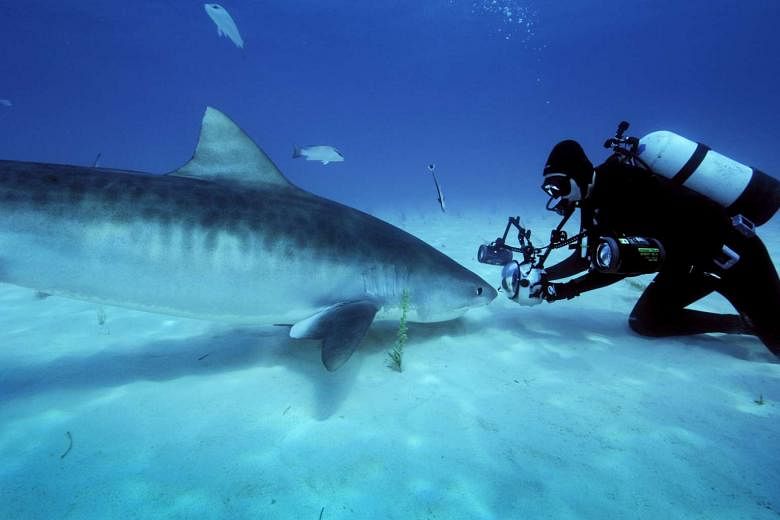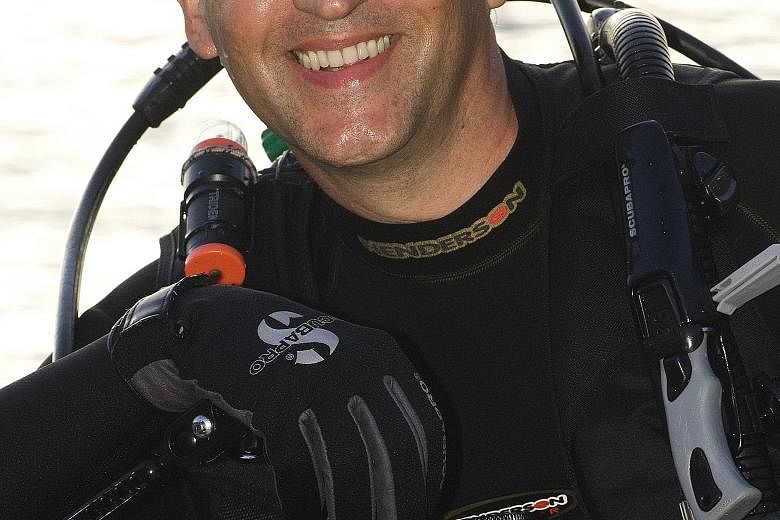Eight to nine months each year, photographer Brian Skerry dives deep into the world's oceans and shoots sharks, dolphins, whales and pretty much any other marine creature you can think of.
The 54-year-old American has clocked more than 10,000 hours underwater across all seven continents yet feels that "there is still so much more to be seen".
He says in a telephone interview with Life from Massachusetts, where he is based: "There are so many mysteries out there and most of the ocean remains unexplored. Every time I go underwater, there is the potential to see something that's never been seen before."
Skerry, who has worked with the National Geographic since 1998, will be in town on Jan 24 to shed light on the creatures that live in the deep unknown through his photographs and share how he undertakes these assignments.
From getting up close to endangered harp seals in Canada to dancing with tiger sharks in the Bahamas, some might say he has one of the best jobs in the world.
Growing up in a small town in New England in the United States, he dreamt of being an explorer of the ocean from a young age.
National Geographic was the per- fect organisation to work for as he considers it "the Mount Everest" for underwater photographers. "It was the place that the greatest photographers were working for and that's what I wanted to do."
He is married with two daughters. He is a passionate advocate for ocean conservation. "A lot of my work has evolved to a point where I'm looking at issues that face the ocean today from endangered species to threats such as overfishing."
-
BOOK IT / OCEAN WILD WITH BRIAN SKERRY
-
WHERE: Esplanade Concert Hall
WHEN: Jan 24, 3pm
ADMISSION: $39 to $69 (excludes booking fee)
INFO: Go to www.sistic.com.sg or call 6348-5555
He is optimistic that things can change for the better. "It's not too late. We can turn things around and improve it. We just have to choose to do so."
Q: When did you realise that being an underwater photographer was what you wanted to do?
I was fascinated by the ocean from a very young age. When I was 15, I began scuba diving. I attended a diving conference where photographers and film-makers presented their works and I realised that it seemed like the perfect career - being an ocean explorer with a camera.
Q: What characteristics are necessary for an underwater photographer?
Being a resourceful, patient and good problem solver, and being prepared are important as you can't predict and force situations underwater. One thing that many don't think about is having good people skills. Most of the time, you are talking to scientists, fishermen or boat captains. You have to be able to work with all kinds of people.
Q: Is it more challenging to photograph wild animals underwater than on land?
Yes. My colleagues who do photography on land would argue about this, but the truth is, it is harder.
As an underwater photographer, I can be in the water only as long as the air supply on my back lasts, so I might be able to spend only up to an hour on a typical dive.
I don't have the luxury of using a 600mm camera lens. Every photo underwater is taken within a couple of metres of the subject. I can't change the lens or film.
I have to dive with the forethought that I'm going to go underwater with this particular equipment and, hopefully, I see this particular animal.
Q: What has been your most memorable assignment thus far?
Shooting a newly discovered population of right whales in Auckland Islands, New Zealand, that no one had ever photographed before.
I was blown away by how curious they were about me. Imagine swimming on the ocean floor in cold water and there is nobody for hundreds of miles around and you are with a whale that is 15m long and weighs 70 tonnes and it is looking at you with those big eyes and choosing to be with you. That's pretty memorable.
Q: Is there one marine creature that you have always loved shooting?
I never tire of shooting sharks. For a photographer, they represent the perfect blend of grace and power.
They are very elegant and move exquisitely through the water yet exude great strength. Also, they need a lot of help so it's good to show them in a nice light.
Q: Many perceive sharks as highly dangerous predators of the sea. Do you agree with this?
Sharks are definitely wild animals, just like tigers or lions, but not anywhere near as bad as people have made them out to be.
Yes, they are potentially dangerous but I don't think we need to be afraid of them or make them out to be monsters. They aren't interested in eating us for the most part and have been around for more than 300 million years.
Through what I do, I hope to get more people to see sharks in a new light.
Q: In your presentations and photos, you draw attention to the issues that plague the ocean. How bad is it?
It is pretty bad and many are not aware of this. A scientific paper published almost a decade ago stated that 90 per cent of the big fish such as tuna and sharks have disappeared in the last 60 years because of commercial overfishing.
We have almost taken them all and it's the same with many other species. We continue to take and take and take, and this is wildlife, not cows on a farm.
The problems are great, but I'm hopeful as we live in a time where we have this information. People a generation ago did not know the details. As bad as it is, we can turn things around and make it good.
Q: How would you like to be remembered?
As somebody who inspired others through my work and was able to shine a light on portions of our planet that made people take notice.


